1995 JEEP CHEROKEE fuel type
[x] Cancel search: fuel typePage 1247 of 2198
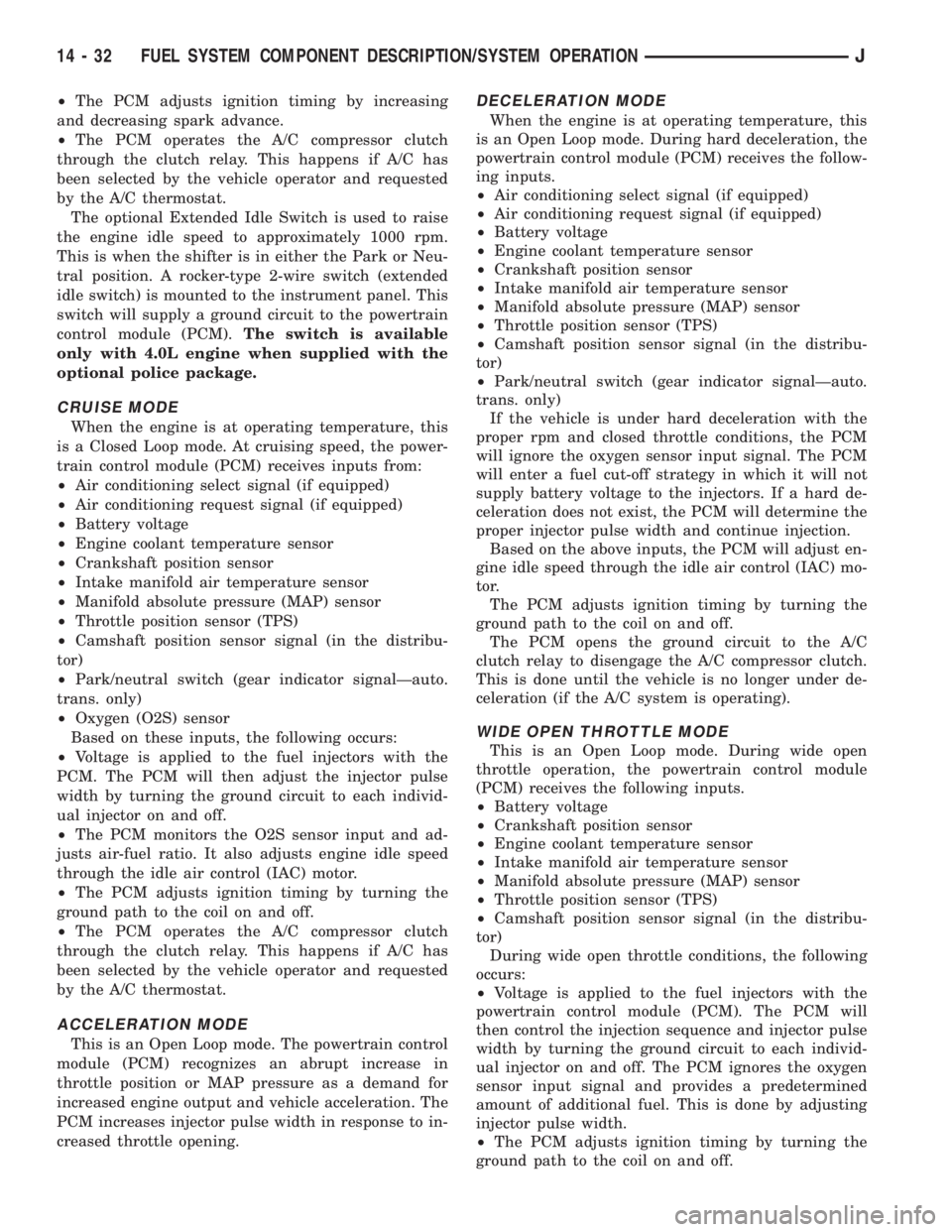
²The PCM adjusts ignition timing by increasing
and decreasing spark advance.
²The PCM operates the A/C compressor clutch
through the clutch relay. This happens if A/C has
been selected by the vehicle operator and requested
by the A/C thermostat.
The optional Extended Idle Switch is used to raise
the engine idle speed to approximately 1000 rpm.
This is when the shifter is in either the Park or Neu-
tral position. A rocker-type 2-wire switch (extended
idle switch) is mounted to the instrument panel. This
switch will supply a ground circuit to the powertrain
control module (PCM).The switch is available
only with 4.0L engine when supplied with the
optional police package.
CRUISE MODE
When the engine is at operating temperature, this
is a Closed Loop mode. At cruising speed, the power-
train control module (PCM) receives inputs from:
²Air conditioning select signal (if equipped)
²Air conditioning request signal (if equipped)
²Battery voltage
²Engine coolant temperature sensor
²Crankshaft position sensor
²Intake manifold air temperature sensor
²Manifold absolute pressure (MAP) sensor
²Throttle position sensor (TPS)
²Camshaft position sensor signal (in the distribu-
tor)
²Park/neutral switch (gear indicator signalÐauto.
trans. only)
²Oxygen (O2S) sensor
Based on these inputs, the following occurs:
²Voltage is applied to the fuel injectors with the
PCM. The PCM will then adjust the injector pulse
width by turning the ground circuit to each individ-
ual injector on and off.
²The PCM monitors the O2S sensor input and ad-
justs air-fuel ratio. It also adjusts engine idle speed
through the idle air control (IAC) motor.
²The PCM adjusts ignition timing by turning the
ground path to the coil on and off.
²The PCM operates the A/C compressor clutch
through the clutch relay. This happens if A/C has
been selected by the vehicle operator and requested
by the A/C thermostat.
ACCELERATION MODE
This is an Open Loop mode. The powertrain control
module (PCM) recognizes an abrupt increase in
throttle position or MAP pressure as a demand for
increased engine output and vehicle acceleration. The
PCM increases injector pulse width in response to in-
creased throttle opening.
DECELERATION MODE
When the engine is at operating temperature, this
is an Open Loop mode. During hard deceleration, the
powertrain control module (PCM) receives the follow-
ing inputs.
²Air conditioning select signal (if equipped)
²Air conditioning request signal (if equipped)
²Battery voltage
²Engine coolant temperature sensor
²Crankshaft position sensor
²Intake manifold air temperature sensor
²Manifold absolute pressure (MAP) sensor
²Throttle position sensor (TPS)
²Camshaft position sensor signal (in the distribu-
tor)
²Park/neutral switch (gear indicator signalÐauto.
trans. only)
If the vehicle is under hard deceleration with the
proper rpm and closed throttle conditions, the PCM
will ignore the oxygen sensor input signal. The PCM
will enter a fuel cut-off strategy in which it will not
supply battery voltage to the injectors. If a hard de-
celeration does not exist, the PCM will determine the
proper injector pulse width and continue injection.
Based on the above inputs, the PCM will adjust en-
gine idle speed through the idle air control (IAC) mo-
tor.
The PCM adjusts ignition timing by turning the
ground path to the coil on and off.
The PCM opens the ground circuit to the A/C
clutch relay to disengage the A/C compressor clutch.
This is done until the vehicle is no longer under de-
celeration (if the A/C system is operating).
WIDE OPEN THROTTLE MODE
This is an Open Loop mode. During wide open
throttle operation, the powertrain control module
(PCM) receives the following inputs.
²Battery voltage
²Crankshaft position sensor
²Engine coolant temperature sensor
²Intake manifold air temperature sensor
²Manifold absolute pressure (MAP) sensor
²Throttle position sensor (TPS)
²Camshaft position sensor signal (in the distribu-
tor)
During wide open throttle conditions, the following
occurs:
²Voltage is applied to the fuel injectors with the
powertrain control module (PCM). The PCM will
then control the injection sequence and injector pulse
width by turning the ground circuit to each individ-
ual injector on and off. The PCM ignores the oxygen
sensor input signal and provides a predetermined
amount of additional fuel. This is done by adjusting
injector pulse width.
²The PCM adjusts ignition timing by turning the
ground path to the coil on and off.
14 - 32 FUEL SYSTEM COMPONENT DESCRIPTION/SYSTEM OPERATIONJ
Page 1249 of 2198
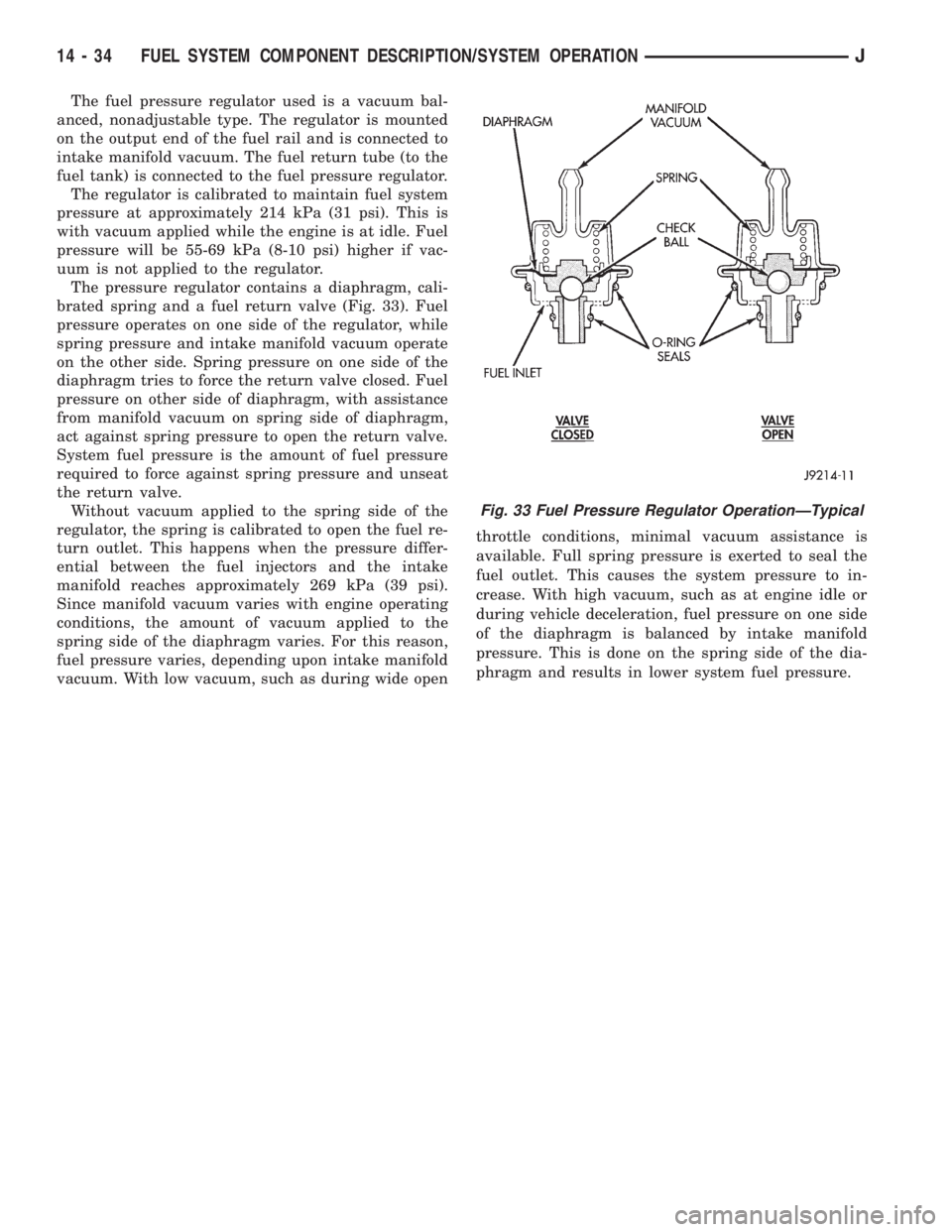
The fuel pressure regulator used is a vacuum bal-
anced, nonadjustable type. The regulator is mounted
on the output end of the fuel rail and is connected to
intake manifold vacuum. The fuel return tube (to the
fuel tank) is connected to the fuel pressure regulator.
The regulator is calibrated to maintain fuel system
pressure at approximately 214 kPa (31 psi). This is
with vacuum applied while the engine is at idle. Fuel
pressure will be 55-69 kPa (8-10 psi) higher if vac-
uum is not applied to the regulator.
The pressure regulator contains a diaphragm, cali-
brated spring and a fuel return valve (Fig. 33). Fuel
pressure operates on one side of the regulator, while
spring pressure and intake manifold vacuum operate
on the other side. Spring pressure on one side of the
diaphragm tries to force the return valve closed. Fuel
pressure on other side of diaphragm, with assistance
from manifold vacuum on spring side of diaphragm,
act against spring pressure to open the return valve.
System fuel pressure is the amount of fuel pressure
required to force against spring pressure and unseat
the return valve.
Without vacuum applied to the spring side of the
regulator, the spring is calibrated to open the fuel re-
turn outlet. This happens when the pressure differ-
ential between the fuel injectors and the intake
manifold reaches approximately 269 kPa (39 psi).
Since manifold vacuum varies with engine operating
conditions, the amount of vacuum applied to the
spring side of the diaphragm varies. For this reason,
fuel pressure varies, depending upon intake manifold
vacuum. With low vacuum, such as during wide openthrottle conditions, minimal vacuum assistance is
available. Full spring pressure is exerted to seal the
fuel outlet. This causes the system pressure to in-
crease. With high vacuum, such as at engine idle or
during vehicle deceleration, fuel pressure on one side
of the diaphragm is balanced by intake manifold
pressure. This is done on the spring side of the dia-
phragm and results in lower system fuel pressure.
Fig. 33 Fuel Pressure Regulator OperationÐTypical
14 - 34 FUEL SYSTEM COMPONENT DESCRIPTION/SYSTEM OPERATIONJ
Page 1263 of 2198
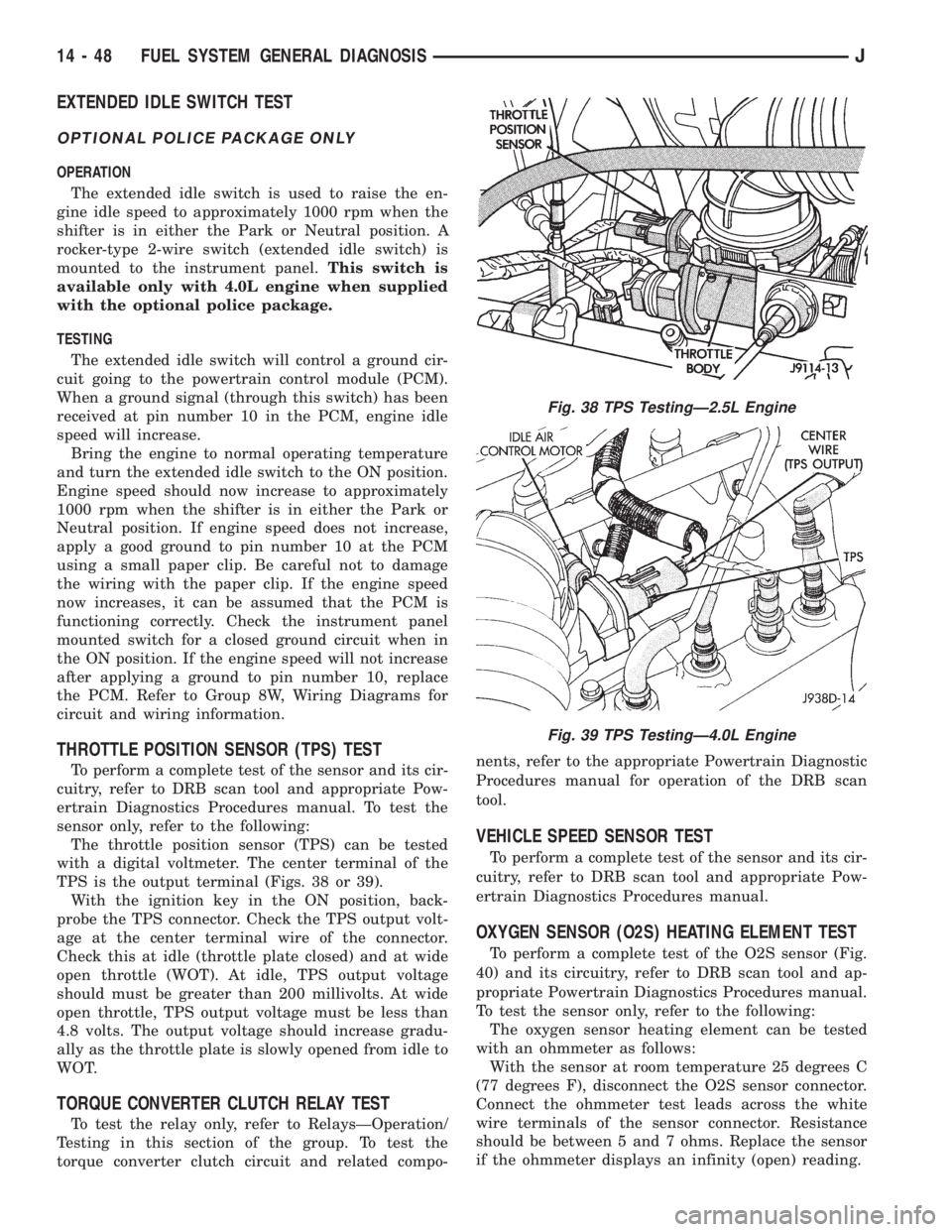
EXTENDED IDLE SWITCH TEST
OPTIONAL POLICE PACKAGE ONLY
OPERATION
The extended idle switch is used to raise the en-
gine idle speed to approximately 1000 rpm when the
shifter is in either the Park or Neutral position. A
rocker-type 2-wire switch (extended idle switch) is
mounted to the instrument panel.This switch is
available only with 4.0L engine when supplied
with the optional police package.
TESTING
The extended idle switch will control a ground cir-
cuit going to the powertrain control module (PCM).
When a ground signal (through this switch) has been
received at pin number 10 in the PCM, engine idle
speed will increase.
Bring the engine to normal operating temperature
and turn the extended idle switch to the ON position.
Engine speed should now increase to approximately
1000 rpm when the shifter is in either the Park or
Neutral position. If engine speed does not increase,
apply a good ground to pin number 10 at the PCM
using a small paper clip. Be careful not to damage
the wiring with the paper clip. If the engine speed
now increases, it can be assumed that the PCM is
functioning correctly. Check the instrument panel
mounted switch for a closed ground circuit when in
the ON position. If the engine speed will not increase
after applying a ground to pin number 10, replace
the PCM. Refer to Group 8W, Wiring Diagrams for
circuit and wiring information.
THROTTLE POSITION SENSOR (TPS) TEST
To perform a complete test of the sensor and its cir-
cuitry, refer to DRB scan tool and appropriate Pow-
ertrain Diagnostics Procedures manual. To test the
sensor only, refer to the following:
The throttle position sensor (TPS) can be tested
with a digital voltmeter. The center terminal of the
TPS is the output terminal (Figs. 38 or 39).
With the ignition key in the ON position, back-
probe the TPS connector. Check the TPS output volt-
age at the center terminal wire of the connector.
Check this at idle (throttle plate closed) and at wide
open throttle (WOT). At idle, TPS output voltage
should must be greater than 200 millivolts. At wide
open throttle, TPS output voltage must be less than
4.8 volts. The output voltage should increase gradu-
ally as the throttle plate is slowly opened from idle to
WOT.
TORQUE CONVERTER CLUTCH RELAY TEST
To test the relay only, refer to RelaysÐOperation/
Testing in this section of the group. To test the
torque converter clutch circuit and related compo-nents, refer to the appropriate Powertrain Diagnostic
Procedures manual for operation of the DRB scan
tool.
VEHICLE SPEED SENSOR TEST
To perform a complete test of the sensor and its cir-
cuitry, refer to DRB scan tool and appropriate Pow-
ertrain Diagnostics Procedures manual.
OXYGEN SENSOR (O2S) HEATING ELEMENT TEST
To perform a complete test of the O2S sensor (Fig.
40) and its circuitry, refer to DRB scan tool and ap-
propriate Powertrain Diagnostics Procedures manual.
To test the sensor only, refer to the following:
The oxygen sensor heating element can be tested
with an ohmmeter as follows:
With the sensor at room temperature 25 degrees C
(77 degrees F), disconnect the O2S sensor connector.
Connect the ohmmeter test leads across the white
wire terminals of the sensor connector. Resistance
should be between 5 and 7 ohms. Replace the sensor
if the ohmmeter displays an infinity (open) reading.
Fig. 38 TPS TestingÐ2.5L Engine
Fig. 39 TPS TestingÐ4.0L Engine
14 - 48 FUEL SYSTEM GENERAL DIAGNOSISJ
Page 1273 of 2198
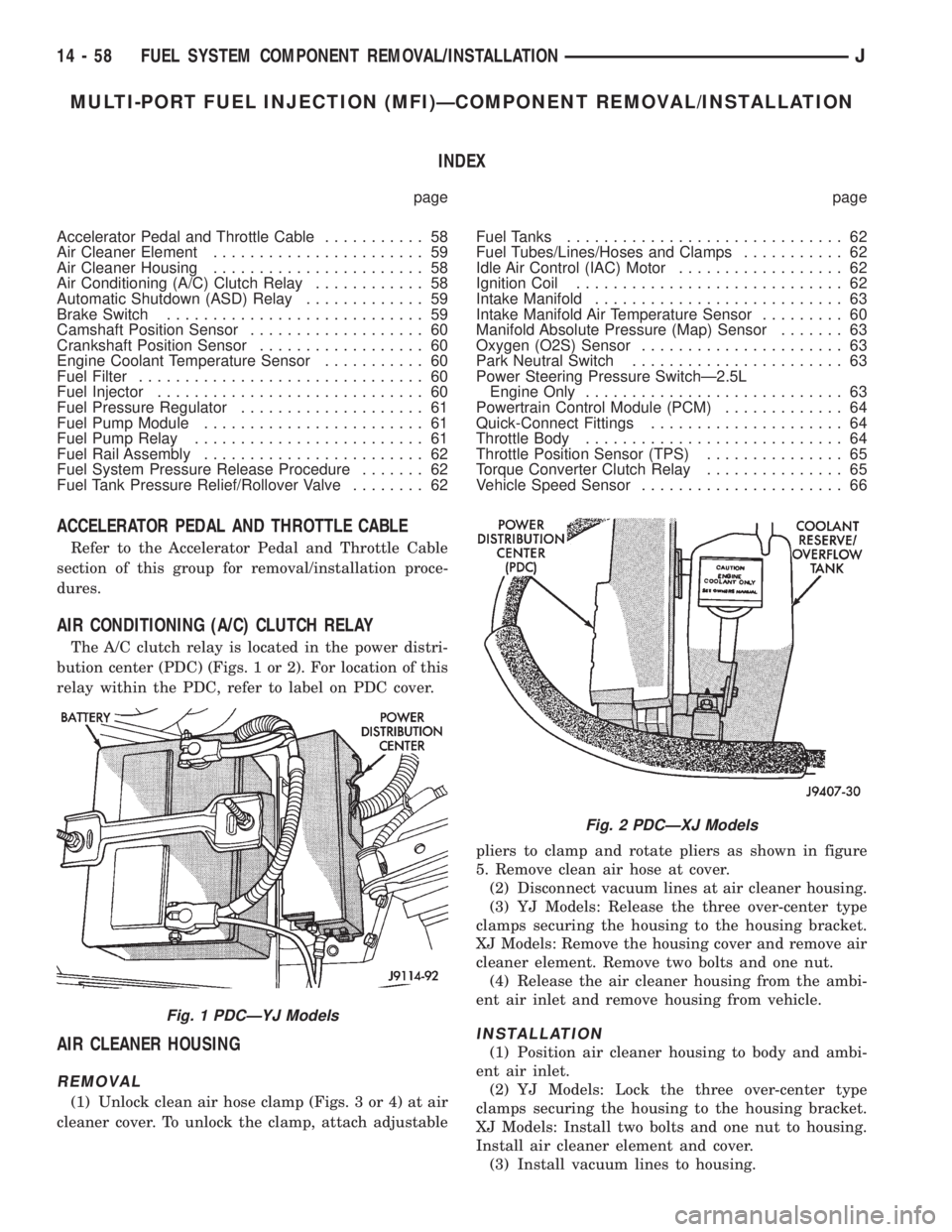
MULTI-PORT FUEL INJECTION (MFI)ÐCOMPONENT REMOVAL/INSTALLATION
INDEX
page page
Accelerator Pedal and Throttle Cable........... 58
Air Cleaner Element....................... 59
Air Cleaner Housing....................... 58
Air Conditioning (A/C) Clutch Relay............ 58
Automatic Shutdown (ASD) Relay............. 59
Brake Switch............................ 59
Camshaft Position Sensor................... 60
Crankshaft Position Sensor.................. 60
Engine Coolant Temperature Sensor........... 60
Fuel Filter............................... 60
Fuel Injector............................. 60
Fuel Pressure Regulator.................... 61
Fuel Pump Module........................ 61
Fuel Pump Relay......................... 61
Fuel Rail Assembly........................ 62
Fuel System Pressure Release Procedure....... 62
Fuel Tank Pressure Relief/Rollover Valve........ 62Fuel Tanks.............................. 62
Fuel Tubes/Lines/Hoses and Clamps........... 62
Idle Air Control (IAC) Motor.................. 62
Ignition Coil............................. 62
Intake Manifold........................... 63
Intake Manifold Air Temperature Sensor......... 60
Manifold Absolute Pressure (Map) Sensor....... 63
Oxygen (O2S) Sensor...................... 63
Park Neutral Switch....................... 63
Power Steering Pressure SwitchÐ2.5L
Engine Only............................ 63
Powertrain Control Module (PCM)............. 64
Quick-Connect Fittings..................... 64
Throttle Body............................ 64
Throttle Position Sensor (TPS)............... 65
Torque Converter Clutch Relay............... 65
Vehicle Speed Sensor...................... 66
ACCELERATOR PEDAL AND THROTTLE CABLE
Refer to the Accelerator Pedal and Throttle Cable
section of this group for removal/installation proce-
dures.
AIR CONDITIONING (A/C) CLUTCH RELAY
The A/C clutch relay is located in the power distri-
bution center (PDC) (Figs. 1 or 2). For location of this
relay within the PDC, refer to label on PDC cover.
AIR CLEANER HOUSING
REMOVAL
(1) Unlock clean air hose clamp (Figs. 3 or 4) at air
cleaner cover. To unlock the clamp, attach adjustablepliers to clamp and rotate pliers as shown in figure
5. Remove clean air hose at cover.
(2) Disconnect vacuum lines at air cleaner housing.
(3) YJ Models: Release the three over-center type
clamps securing the housing to the housing bracket.
XJ Models: Remove the housing cover and remove air
cleaner element. Remove two bolts and one nut.
(4) Release the air cleaner housing from the ambi-
ent air inlet and remove housing from vehicle.
INSTALLATION
(1) Position air cleaner housing to body and ambi-
ent air inlet.
(2) YJ Models: Lock the three over-center type
clamps securing the housing to the housing bracket.
XJ Models: Install two bolts and one nut to housing.
Install air cleaner element and cover.
(3) Install vacuum lines to housing.
Fig. 1 PDCÐYJ Models
Fig. 2 PDCÐXJ Models
14 - 58 FUEL SYSTEM COMPONENT REMOVAL/INSTALLATIONJ
Page 1723 of 2198
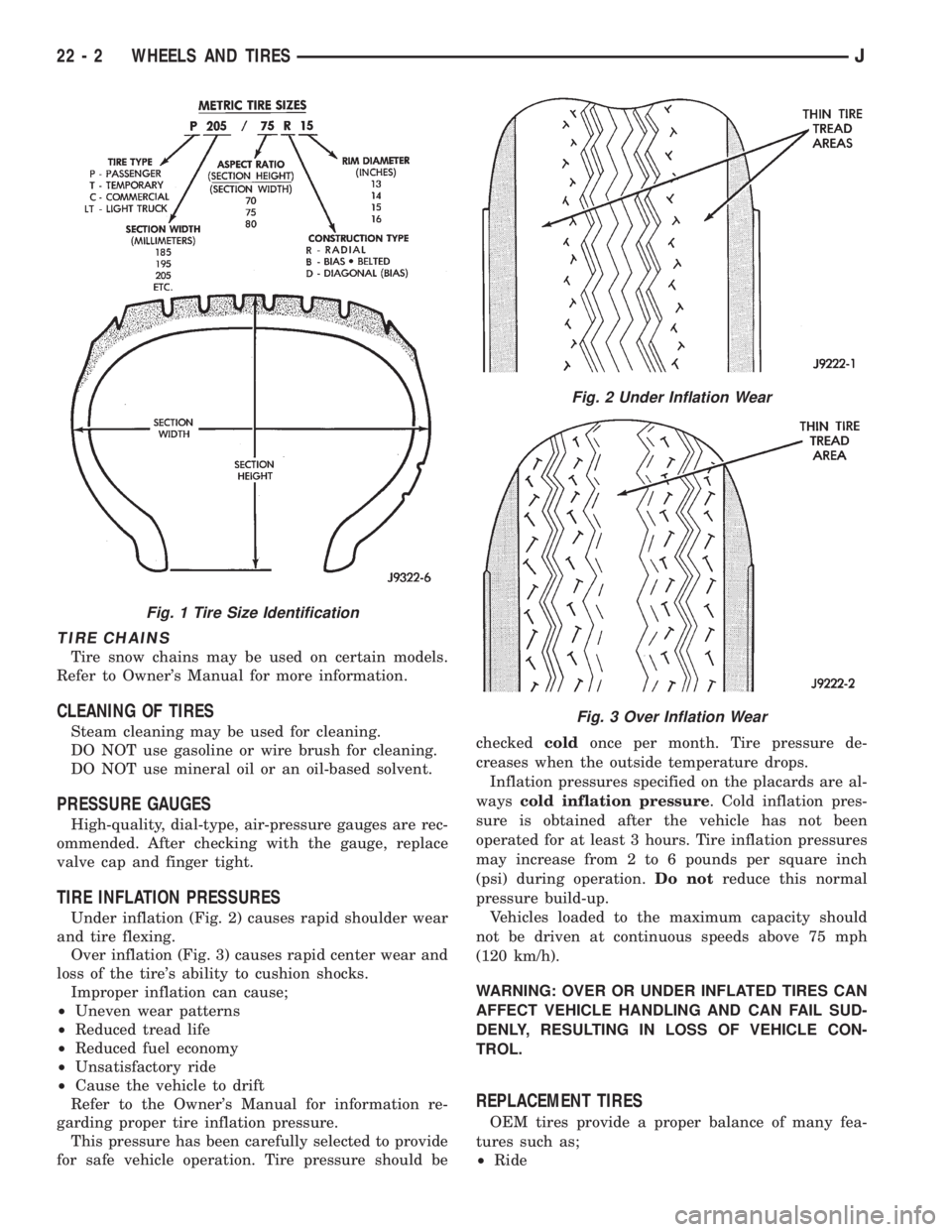
TIRE CHAINS
Tire snow chains may be used on certain models.
Refer to Owner's Manual for more information.
CLEANING OF TIRES
Steam cleaning may be used for cleaning.
DO NOT use gasoline or wire brush for cleaning.
DO NOT use mineral oil or an oil-based solvent.
PRESSURE GAUGES
High-quality, dial-type, air-pressure gauges are rec-
ommended. After checking with the gauge, replace
valve cap and finger tight.
TIRE INFLATION PRESSURES
Under inflation (Fig. 2) causes rapid shoulder wear
and tire flexing.
Over inflation (Fig. 3) causes rapid center wear and
loss of the tire's ability to cushion shocks.
Improper inflation can cause;
²Uneven wear patterns
²Reduced tread life
²Reduced fuel economy
²Unsatisfactory ride
²Cause the vehicle to drift
Refer to the Owner's Manual for information re-
garding proper tire inflation pressure.
This pressure has been carefully selected to provide
for safe vehicle operation. Tire pressure should becheckedcoldonce per month. Tire pressure de-
creases when the outside temperature drops.
Inflation pressures specified on the placards are al-
wayscold inflation pressure. Cold inflation pres-
sure is obtained after the vehicle has not been
operated for at least 3 hours. Tire inflation pressures
may increase from 2 to 6 pounds per square inch
(psi) during operation.Do notreduce this normal
pressure build-up.
Vehicles loaded to the maximum capacity should
not be driven at continuous speeds above 75 mph
(120 km/h).
WARNING: OVER OR UNDER INFLATED TIRES CAN
AFFECT VEHICLE HANDLING AND CAN FAIL SUD-
DENLY, RESULTING IN LOSS OF VEHICLE CON-
TROL.
REPLACEMENT TIRES
OEM tires provide a proper balance of many fea-
tures such as;
²Ride
Fig. 1 Tire Size Identification
Fig. 2 Under Inflation Wear
Fig. 3 Over Inflation Wear
22 - 2 WHEELS AND TIRESJ
Page 1811 of 2198
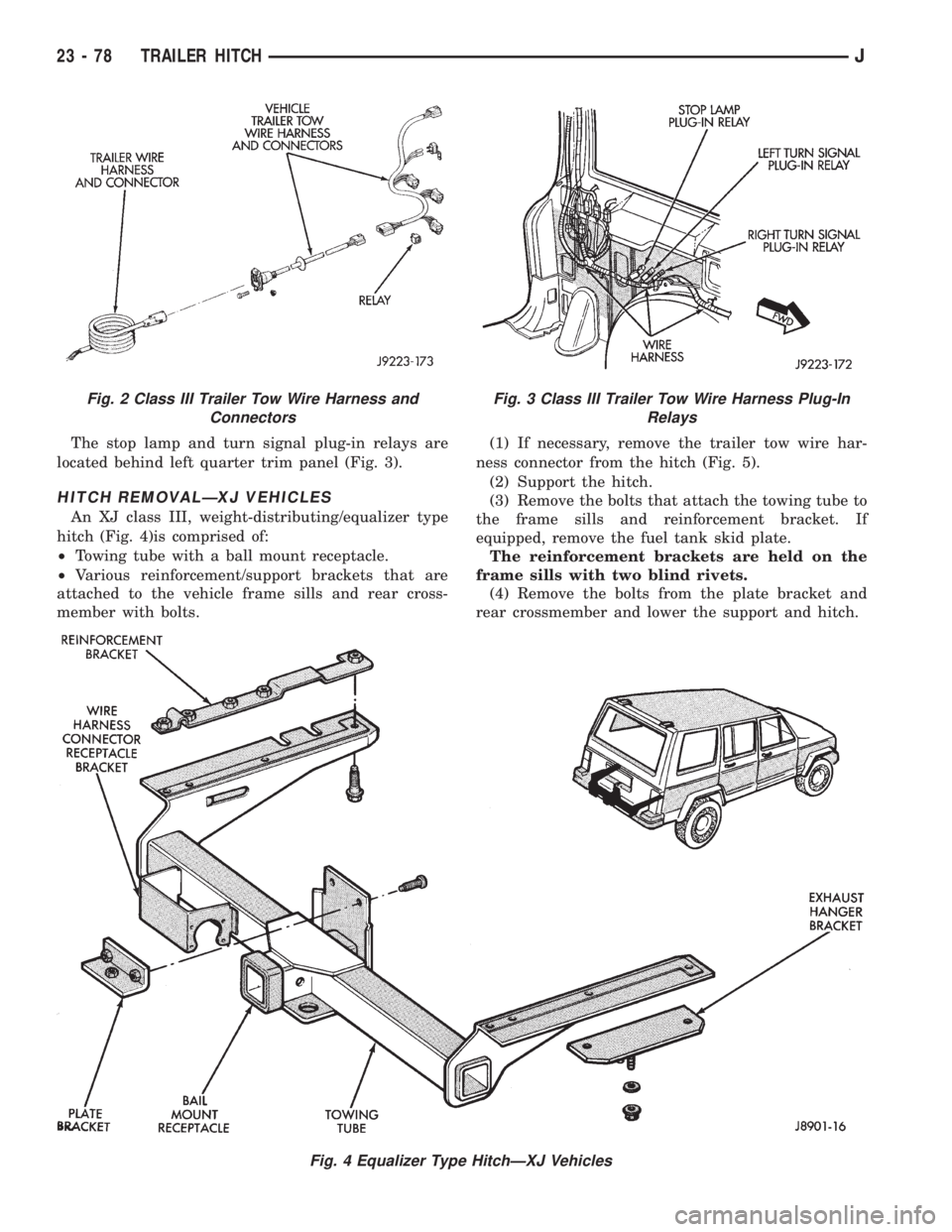
The stop lamp and turn signal plug-in relays are
located behind left quarter trim panel (Fig. 3).
HITCH REMOVALÐXJ VEHICLES
An XJ class III, weight-distributing/equalizer type
hitch (Fig. 4)is comprised of:
²Towing tube with a ball mount receptacle.
²Various reinforcement/support brackets that are
attached to the vehicle frame sills and rear cross-
member with bolts.(1) If necessary, remove the trailer tow wire har-
ness connector from the hitch (Fig. 5).
(2) Support the hitch.
(3) Remove the bolts that attach the towing tube to
the frame sills and reinforcement bracket. If
equipped, remove the fuel tank skid plate.
The reinforcement brackets are held on the
frame sills with two blind rivets.
(4) Remove the bolts from the plate bracket and
rear crossmember and lower the support and hitch.
Fig. 4 Equalizer Type HitchÐXJ Vehicles
Fig. 2 Class III Trailer Tow Wire Harness and
ConnectorsFig. 3 Class III Trailer Tow Wire Harness Plug-In
Relays
23 - 78 TRAILER HITCHJ
Page 1992 of 2198
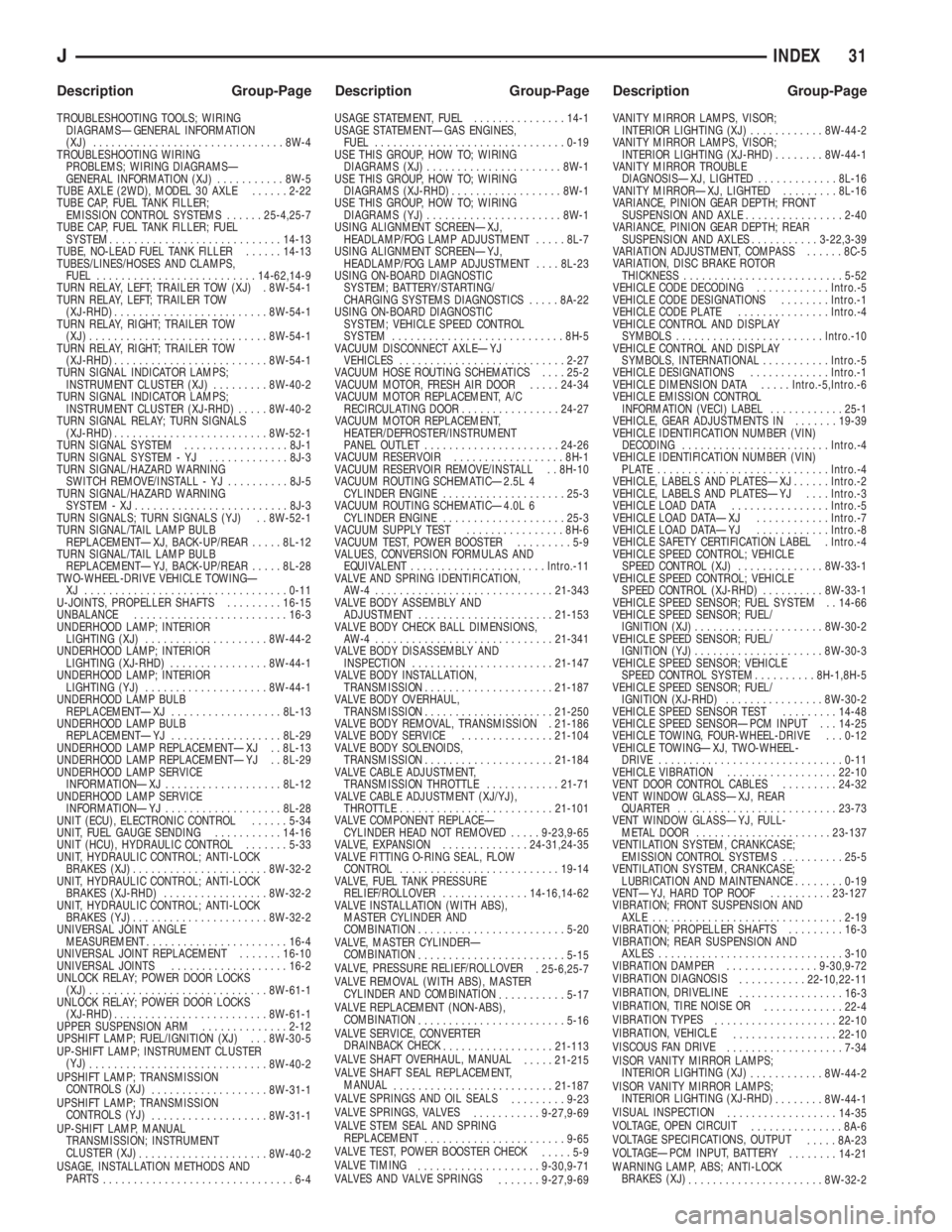
TROUBLESHOOTING TOOLS; WIRING
DIAGRAMSÐGENERAL INFORMATION
(XJ)...............................8W-4
TROUBLESHOOTING WIRING
PROBLEMS; WIRING DIAGRAMSÐ
GENERAL INFORMATION (XJ)...........8W-5
TUBE AXLE (2WD), MODEL 30 AXLE......2-22
TUBE CAP, FUEL TANK FILLER;
EMISSION CONTROL SYSTEMS......25-4,25-7
TUBE CAP, FUEL TANK FILLER; FUEL
SYSTEM............................14-13
TUBE, NO-LEAD FUEL TANK FILLER......14-13
TUBES/LINES/HOSES AND CLAMPS,
FUEL..........................14-62,14-9
TURN RELAY, LEFT; TRAILER TOW (XJ) . 8W-54-1
TURN RELAY, LEFT; TRAILER TOW
(XJ-RHD).........................8W-54-1
TURN RELAY, RIGHT; TRAILER TOW
(XJ).............................8W-54-1
TURN RELAY, RIGHT; TRAILER TOW
(XJ-RHD).........................8W-54-1
TURN SIGNAL INDICATOR LAMPS;
INSTRUMENT CLUSTER (XJ).........8W-40-2
TURN SIGNAL INDICATOR LAMPS;
INSTRUMENT CLUSTER (XJ-RHD).....8W-40-2
TURN SIGNAL RELAY; TURN SIGNALS
(XJ-RHD).........................8W-52-1
TURN SIGNAL SYSTEM.................8J-1
TURN SIGNAL SYSTEM - YJ.............8J-3
TURN SIGNAL/HAZARD WARNING
SWITCH REMOVE/INSTALL - YJ..........8J-5
TURN SIGNAL/HAZARD WARNING
SYSTEM - XJ..........................8J-3
TURN SIGNALS; TURN SIGNALS (YJ) . . 8W-52-1
TURN SIGNAL/TAIL LAMP BULB
REPLACEMENTÐXJ, BACK-UP/REAR.....8L-12
TURN SIGNAL/TAIL LAMP BULB
REPLACEMENTÐYJ, BACK-UP/REAR.....8L-28
TWO-WHEEL-DRIVE VEHICLE TOWINGÐ
XJ .................................0-11
U-JOINTS, PROPELLER SHAFTS.........16-15
UNBALANCE.........................16-3
UNDERHOOD LAMP; INTERIOR
LIGHTING (XJ)....................8W-44-2
UNDERHOOD LAMP; INTERIOR
LIGHTING (XJ-RHD)................8W-44-1
UNDERHOOD LAMP; INTERIOR
LIGHTING (YJ)....................8W-44-1
UNDERHOOD LAMP BULB
REPLACEMENTÐXJ..................8L-13
UNDERHOOD LAMP BULB
REPLACEMENTÐYJ..................8L-29
UNDERHOOD LAMP REPLACEMENTÐXJ . . 8L-13
UNDERHOOD LAMP REPLACEMENTÐYJ . . 8L-29
UNDERHOOD LAMP SERVICE
INFORMATIONÐXJ...................8L-12
UNDERHOOD LAMP SERVICE
INFORMATIONÐYJ...................8L-28
UNIT (ECU), ELECTRONIC CONTROL......5-34
UNIT, FUEL GAUGE SENDING...........14-16
UNIT (HCU), HYDRAULIC CONTROL.......5-33
UNIT, HYDRAULIC CONTROL; ANTI-LOCK
BRAKES (XJ)......................8W-32-2
UNIT, HYDRAULIC CONTROL; ANTI-LOCK
BRAKES (XJ-RHD).................8W-32-2
UNIT, HYDRAULIC CONTROL; ANTI-LOCK
BRAKES (YJ)......................8W-32-2
UNIVERSAL JOINT ANGLE
MEASUREMENT.......................16-4
UNIVERSAL JOINT REPLACEMENT.......16-10
UNIVERSAL JOINTS...................16-2
UNLOCK RELAY; POWER DOOR LOCKS
(XJ).............................8W-61-1
UNLOCK RELAY; POWER DOOR LOCKS
(XJ-RHD).........................8W-61-1
UPPER SUSPENSION ARM..............2-12
UPSHIFT LAMP; FUEL/IGNITION (XJ) . . . 8W-30-5
UP-SHIFT LAMP; INSTRUMENT CLUSTER
(YJ)
.............................8W-40-2
UPSHIFT LAMP; TRANSMISSION
CONTROLS (XJ)
...................8W-31-1
UPSHIFT LAMP; TRANSMISSION
CONTROLS (YJ)
...................8W-31-1
UP-SHIFT LAMP, MANUAL
TRANSMISSION; INSTRUMENT
CLUSTER (XJ)
.....................8W-40-2
USAGE, INSTALLATION METHODS AND
PARTS
...............................6-4USAGE STATEMENT, FUEL...............14-1
USAGE STATEMENTÐGAS ENGINES,
FUEL...............................0-19
USE THIS GROUP, HOW TO; WIRING
DIAGRAMS (XJ)......................8W-1
USE THIS GROUP, HOW TO; WIRING
DIAGRAMS (XJ-RHD)..................8W-1
USE THIS GROUP, HOW TO; WIRING
DIAGRAMS (YJ)......................8W-1
USING ALIGNMENT SCREENÐXJ,
HEADLAMP/FOG LAMP ADJUSTMENT.....8L-7
USING ALIGNMENT SCREENÐYJ,
HEADLAMP/FOG LAMP ADJUSTMENT....8L-23
USING ON-BOARD DIAGNOSTIC
SYSTEM; BATTERY/STARTING/
CHARGING SYSTEMS DIAGNOSTICS.....8A-22
USING ON-BOARD DIAGNOSTIC
SYSTEM; VEHICLE SPEED CONTROL
SYSTEM............................8H-5
VACUUM DISCONNECT AXLEÐYJ
VEHICLES...........................2-27
VACUUM HOSE ROUTING SCHEMATICS....25-2
VACUUM MOTOR, FRESH AIR DOOR.....24-34
VACUUM MOTOR REPLACEMENT, A/C
RECIRCULATING DOOR................24-27
VACUUM MOTOR REPLACEMENT,
HEATER/DEFROSTER/INSTRUMENT
PANEL OUTLET......................24-26
VACUUM RESERVOIR..................8H-1
VACUUM RESERVOIR REMOVE/INSTALL . . 8H-10
VACUUM ROUTING SCHEMATICÐ2.5L 4
CYLINDER ENGINE....................25-3
VACUUM ROUTING SCHEMATICÐ4.0L 6
CYLINDER ENGINE....................25-3
VACUUM SUPPLY TEST................8H-6
VACUUM TEST, POWER BOOSTER.........5-9
VALUES, CONVERSION FORMULAS AND
EQUIVALENT......................Intro.-11
VALVE AND SPRING IDENTIFICATION,
AW-4 .............................21-343
VALVE BODY ASSEMBLY AND
ADJUSTMENT......................21-153
VALVE BODY CHECK BALL DIMENSIONS,
AW-4 .............................21-341
VALVE BODY DISASSEMBLY AND
INSPECTION.......................21-147
VALVE BODY INSTALLATION,
TRANSMISSION.....................21-187
VALVE BODY OVERHAUL,
TRANSMISSION.....................21-250
VALVE BODY REMOVAL, TRANSMISSION . 21-186
VALVE BODY SERVICE...............21-104
VALVE BODY SOLENOIDS,
TRANSMISSION.....................21-184
VALVE CABLE ADJUSTMENT,
TRANSMISSION THROTTLE............21-71
VALVE CABLE ADJUSTMENT (XJ/YJ),
THROTTLE.........................21-101
VALVE COMPONENT REPLACEÐ
CYLINDER HEAD NOT REMOVED.....9-23,9-65
VALVE, EXPANSION..............24-31,24-35
VALVE FITTING O-RING SEAL, FLOW
CONTROL..........................19-14
VALVE, FUEL TANK PRESSURE
RELIEF/ROLLOVER..............14-16,14-62
VALVE INSTALLATION (WITH ABS),
MASTER CYLINDER AND
COMBINATION........................5-20
VALVE, MASTER CYLINDERÐ
COMBINATION
........................5-15
VALVE, PRESSURE RELIEF/ROLLOVER
. 25-6,25-7
VALVE REMOVAL (WITH ABS), MASTER
CYLINDER AND COMBINATION
...........5-17
VALVE REPLACEMENT (NON-ABS),
COMBINATION
........................5-16
VALVE SERVICE, CONVERTER
DRAINBACK CHECK
..................21-113
VALVE SHAFT OVERHAUL, MANUAL
.....21-215
VALVE SHAFT SEAL REPLACEMENT,
MANUAL
..........................21-187
VALVE SPRINGS AND OIL SEALS
.........9-23
VALVE SPRINGS, VALVES
...........9-27,9-69
VALVE STEM SEAL AND SPRING
REPLACEMENT
.......................9-65
VALVE TEST, POWER BOOSTER CHECK
.....5-9
VALVE TIMING
....................9-30,9-71
VALVES AND VALVE SPRINGS
.......9-27,9-69VANITY MIRROR LAMPS, VISOR;
INTERIOR LIGHTING (XJ)............8W-44-2
VANITY MIRROR LAMPS, VISOR;
INTERIOR LIGHTING (XJ-RHD)........8W-44-1
VANITY MIRROR TROUBLE
DIAGNOSISÐXJ, LIGHTED.............8L-16
VANITY MIRRORÐXJ, LIGHTED.........8L-16
VARIANCE, PINION GEAR DEPTH; FRONT
SUSPENSION AND AXLE................2-40
VARIANCE, PINION GEAR DEPTH; REAR
SUSPENSION AND AXLES...........3-22,3-39
VARIATION ADJUSTMENT, COMPASS......8C-5
VARIATION, DISC BRAKE ROTOR
THICKNESS..........................5-52
VEHICLE CODE DECODING............Intro.-5
VEHICLE CODE DESIGNATIONS........Intro.-1
VEHICLE CODE PLATE...............Intro.-4
VEHICLE CONTROL AND DISPLAY
SYMBOLS........................Intro.-10
VEHICLE CONTROL AND DISPLAY
SYMBOLS, INTERNATIONAL...........Intro.-5
VEHICLE DESIGNATIONS.............Intro.-1
VEHICLE DIMENSION DATA.....Intro.-5,Intro.-6
VEHICLE EMISSION CONTROL
INFORMATION (VECI) LABEL............25-1
VEHICLE, GEAR ADJUSTMENTS IN.......19-39
VEHICLE IDENTIFICATION NUMBER (VIN)
DECODING........................Intro.-4
VEHICLE IDENTIFICATION NUMBER (VIN)
PLATE ............................Intro.-4
VEHICLE, LABELS AND PLATESÐXJ......Intro.-2
VEHICLE, LABELS AND PLATESÐYJ....Intro.-3
VEHICLE LOAD DATA................Intro.-5
VEHICLE LOAD DATAÐXJ............Intro.-7
VEHICLE LOAD DATAÐYJ............Intro.-8
VEHICLE SAFETY CERTIFICATION LABEL . Intro.-4
VEHICLE SPEED CONTROL; VEHICLE
SPEED CONTROL (XJ)..............8W-33-1
VEHICLE SPEED CONTROL; VEHICLE
SPEED CONTROL (XJ-RHD)..........8W-33-1
VEHICLE SPEED SENSOR; FUEL SYSTEM . . 14-66
VEHICLE SPEED SENSOR; FUEL/
IGNITION (XJ).....................8W-30-2
VEHICLE SPEED SENSOR; FUEL/
IGNITION (YJ).....................8W-30-3
VEHICLE SPEED SENSOR; VEHICLE
SPEED CONTROL SYSTEM..........8H-1,8H-5
VEHICLE SPEED SENSOR; FUEL/
IGNITION (XJ-RHD)................8W-30-2
VEHICLE SPEED SENSOR TEST.........14-48
VEHICLE SPEED SENSORÐPCM INPUT . . . 14-25
VEHICLE TOWING, FOUR-WHEEL-DRIVE . . . 0-12
VEHICLE TOWINGÐXJ, TWO-WHEEL-
DRIVE..............................0-11
VEHICLE VIBRATION..................22-10
VENT DOOR CONTROL CABLES.........24-32
VENT WINDOW GLASSÐXJ, REAR
QUARTER..........................23-73
VENT WINDOW GLASSÐYJ, FULL-
METAL DOOR......................23-137
VENTILATION SYSTEM, CRANKCASE;
EMISSION CONTROL SYSTEMS..........25-5
VENTILATION SYSTEM, CRANKCASE;
LUBRICATION AND MAINTENANCE........0-19
VENTÐYJ, HARD TOP ROOF..........23-127
VIBRATION; FRONT SUSPENSION AND
AXLE...............................2-19
VIBRATION; PROPELLER SHAFTS.........16-3
VIBRATION; REAR SUSPENSION AND
AXLES..............................3-10
VIBRATION DAMPER...............9-30,9-72
VIBRATION DIAGNOSIS
...........22-10,22-11
VIBRATION, DRIVELINE
.................16-3
VIBRATION, TIRE NOISE OR
.............22-4
VIBRATION TYPES
....................22-10
VIBRATION, VEHICLE
.................22-10
VISCOUS FAN DRIVE
...................7-34
VISOR VANITY MIRROR LAMPS;
INTERIOR LIGHTING (XJ)
............8W-44-2
VISOR VANITY MIRROR LAMPS;
INTERIOR LIGHTING (XJ-RHD)
........8W-44-1
VISUAL INSPECTION
..................14-35
VOLTAGE, OPEN CIRCUIT
...............8A-6
VOLTAGE SPECIFICATIONS, OUTPUT
.....8A-23
VOLTAGEÐPCM INPUT, BATTERY
........14-21
WARNING LAMP, ABS; ANTI-LOCK
BRAKES (XJ)
......................8W-32-2
JINDEX 31
Description Group-Page Description Group-Page Description Group-Page